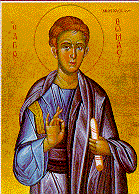



Memory Celebrated August 19
The true Christian, who carries Jesus Christ in his heart, proclaims a love for the Savior, and addresses himself in prayer to God in the name of the Messiah, solemnly acknowledges the divinity of Jesus, and does not need to be prodded in an awareness of the Son of God by any particular occasion or number of occasions. Nevertheless, the Christians who pass in review in a daily parade before God enjoy saluting Jesus on such occasions as Christmas, Epiphany, Easter, and, most intimately, on that day which commemorates the Transfiguration of Jesus Christ.
The transfiguration of Jesus is a miracle outlined in Matthew 17.1-9, Mark 9.2-10, Luke 9.28-36, and the Second Epistle of Peter 1.16-21. The New Testament takes the Christian reader by the hand to join the Apostles Peter, John, and James to accompany Jesus to the top of Mt. Tabor for a personal glimpse of the power of God. The true believer experiences the wondrous awe as Jesus is bathed in a dazzling glow of light and then hears God say "This is my beloved Son, in whom I am well pleased." All present with the Messiah are transfixed as these words are heard by a pair of guests who have come to bear witness to the divine declaration and just happen to be the lawgiver Moses and the Prophet Elijah.
This, then, is known as the transfiguration of Jesus Christ, a day on which God chose to acknowledge his Son with a simple sentence. It could have been a pompous occasion with heavenly choirs and a parade of speakers from on high extolling the Master, but that was not the way God wanted it. It was in its simplicity a grand gesture on the part of God, and also allowed the followers of Jesus Christ for all time to identify with the mortals like themselves who were companions of the humble carpenter from Nazareth. In one brief moment the life of mankind was given true meaning because in embracing his Son, Almighty God embraced all of his children in a simple gesture which sums up the Christian philosophy in the little word "love."
The transfiguration was no mystical, abstract process which needed interpretation or explanation. There was no rhetoric or hyperbole in God's short and sweet pronouncement which may at first appear superfluous, because all present knew that Jesus was the Son of God. But the phrase 'in whom I am well pleased' suggests that in following Jesus Christ, any of the children of God can attain a spiritual plateau with others in whom God is well pleased.
The early Church Fathers who wished to set aside this beautiful episode with a feast day of its own could not agree on the exact date. It was known, however, to have occurred a few weeks before the Crucifixion of Jesus Christ. Since that would come within the Lenten period, they decided to set the date of August 19, forty days before the feast day of the Elevation of the Holy Cross on September 27. Their interest lay not in chronological accuracy, but in assuring that this auspicious occasion be observed on a day when no other observances could detract from its simple solemnity.
The mother of Constantine the Great (the St. Helen whose contributions were enormous in all aspects of Christianity, both temporal and spiritual) was responsible for the erection of a truly magnificent chapel atop Mt. Tabor. It served not only in commemoration, but also as a reminder of the divine visit which took place there in the event observed throughout Orthodox churches as the transfiguration of Jesus Christ. This chapel was followed by churches and monasteries which stood for centuries on Mt. Tabor. The early church historian Origen makes note of this special observance in the Eastern sector not taken up by the Western sector until the fifteenth century.
The transfiguration of Jesus Christ is celebrated in Greece with particular joy and festivity. It ranks below Easter in its importance on the Greek religious calendar, but lacks for nothing in the festive mood created by the more widely known days marking other events in the life of the Savior. The Transfiguration served to fortify the strength of the apostolic faith in the dark days that were to follow, but today it coincides with the harvesting of grapes and the blessing of the vineyard.
Copyright © 1997 — 2003 Orthodox Christian Net, LLC All rights reserved.
